January 25th, 2008 by Susan
From Grand Text Auto, a posting on Erica , what looks to be a generator of poetry that has been developed by Jim Carpenter. Haven’t tried it yet, but marking it for further discovery. Here’s a screenshot (forgive the netnewswire background):
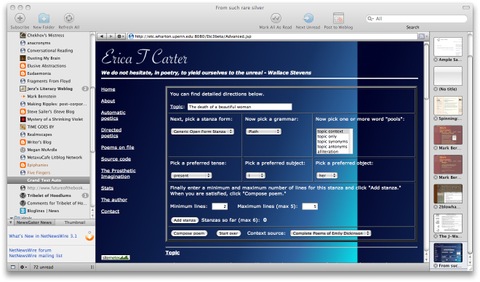
Posted in NEW MEDIA | Comments Off on NEW MEDIA: Erica
January 24th, 2008 by Susan
In going over the mapview of this story by Steve Ersinghaus, I can see the intricate manipulation by the writer to direct the reader to cover all bases even while allowing him/her to select direction by choice. This may visually help answer a question raised by Mary Ellen and addressed by both Steve and Mark Bernstein in this post on Hypertext Aesthetics. She asks: ““I worry constantly that I’m not getting the essence of the story because I don’t know how the writer crafted it.”
Mark responds: “Just as a bard might extend some scenes and foreshorten others, the hypertext writer has (we hope) carefully arranged the links and anticipated your reading.”
I think the map below of a portion of Brimmer and Death reveals the planning that goes into hypertext. If a space or thread is missed because of reader choice, it indeed will change more than the experience of the story, it may change the meaning, mood, or tone. That is both the author’s concern and intent. In the same way, he will ensure that nothing of importance is lost to the reader by his/her own calculations. Note how the writing spaces are linked so that nearly all spaces of this map will be available and read, though not in the same manner. Sequence, then, is key.
As they say, sometimes a picture is worth a thousand words.
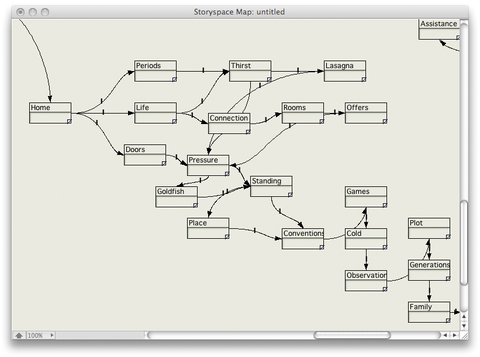
Posted in STORYSPACE | Comments Off on STORYSPACE: Brimmer and Death – Structure
January 23rd, 2008 by Susan
Kind of exciting–I’ve been able to open up my previous work, Paths, which was written into Storyspace for Windows.
Now I’m just too cool for words. Especially linear wordage. I’m a multi-lingual (computer-wise, anyway–though I can sing in Polish) hypertexter.
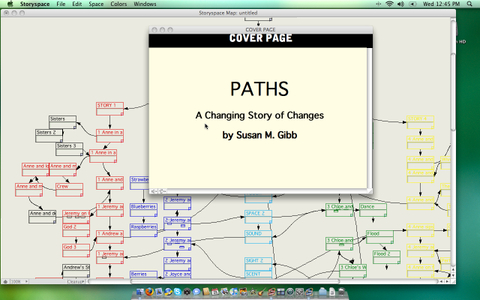
Posted in STORYSPACE | Comments Off on STORYSPACE: Paths for Mac!
January 23rd, 2008 by Susan
Even as I learn the new maneuvering of the Mac world, the atmospheric conditions of creative thought come from all directions. From a friend’s missing of home, a feeling that develops into my own character’s sense of loss:
Empty of soul yet swollen with rage, he drove to the mountains, to the place in the woods where Bonnie and he would set out a campsite. He walked up the trail in a stumbling dead man’s pace. The trees held in their thoughts, quiet despite a light breeze, as if in solemn understanding of his oneness. He stopped in the small clearing off the path, stood and looked around. Then he fell to his knees, his body rowing with sobs as his fingers dug into the earth to unbury his heart.
A bit overwritten in this first thought, but I do see him there.
Posted in STORYSPACE | Comments Off on STORYSPACE: The Hanging – Mood
January 21st, 2008 by Susan
There are so many new programs to learn in Mac that offer similar functioning to what Ive been used to in Windows that I’m playing with them just to become acquainted.
While I’ve never been one to play movies on the computer or run the TV through (why? a 13-inch screen?) it’s been interesting just to see what’s available here. Why it took me a year before I realized that Windows Moviemaker came with the package and was on the laptop waiting for me. But I’m really hot to get the Adobe CS on it so I can at least play in Photoshop a bit.
The Storyspace project is moving slowly as I’m relearning how to do things and finding what I need to make things work. I’ve been writing in the Windows version for now just as the mood hits but not going off in too many trails so it doesn’t get hairy to transfer. A story is developing here but it’s getting more complicated as I take different trails to answer questions raised by the reading.
All in all, aside from a dandruff problem, the Mac has been an interesting experience so far. (For example, putting the link from text to site didn’t work on this last sentence. Now that’s a bummer in a hypertext-minded world.)
Posted in PROJECTS | Comments Off on PROJECTS: Mac-wise
January 19th, 2008 by Susan
I’m slowly adjusting to the new Mac format and never thought I’d say this, but I’m missing some of the old Windows features. I did like the self-contained element of the Writing space, the editing features being available via a toolbar that descended on each space. This seems to be a Mac thing; all the features of an opened program, and all windows open, are ruled by the main top menu bar which changes according to the program opened at the time. Likely this is a good feature of Mac; the Microsoft manner of creating seventeen different ways to do the same thing was more confusing than anything else. Sometimes it’s just change for its own sake that makes something seemingly less attractive. Ruts do tend to fit one’s form more readily.
I’m also having a problem in following space to space (basic) links from Mapview as I either haven’t discovered yet some setting somewhere, or my middle finger tap on the touchpad (yes, after spending $70 on a mated–and likely pregnant–mouse, I’m liking the larger touchpad of the MacBook and getting better at using it) is offensive to the cultured literary attitude of the Storyspace program. The thing is, I must have had it working before because this is how I work in Map. This too, I shall figure out.
The title of the piece has changed. Self Love was the dumbest, but I’m sure that anything with the word ‘suicide’ in it has already been done to death (pun!). So the new title is simply The Hanging. It’s not really about that so much as paths that bring one to the site, and the changes in direction for those left behind. Only with a slightly quirkier take.
This has been quite an experience so far, and with the change in format to Mac, I’m loving the challenges that go beyond what a writer already faces the moment he first put pencil to paper. Change is a good thing. I can deal with change. And nobody’s here to watch as I tap the mousepad and scowl because nothing’s happening.
Posted in STORYSPACE | Comments Off on STORYSPACE: Adjusting
January 18th, 2008 by Susan
Wowey Kazowey, Buffalo Bill. Transferred the story into the Mac format and it’s truly inspirational. For one thing, I can’t write Poe-like into a Porsche. Language and thought process definitely undergoing a change here, and I just shed years off inhibition (though the experience remains, tee-hee!).
Just look at this; Even if I can’t write like Ersinghaus I can at least match him for cool now in Storyspace Map View.
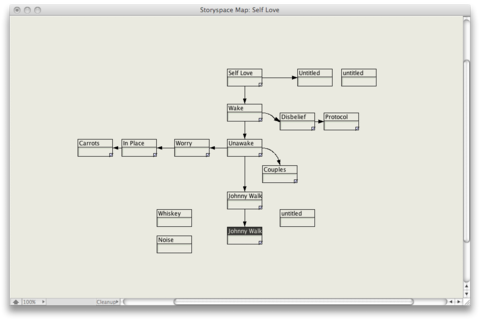
Posted in STORYSPACE | 1 Comment »
January 17th, 2008 by Susan
One of the things Steve mentions in his post on his current hypertext project, Brimmer and Death, is this:
In the beginning, I had no idea that Death would play a role in the story. The story began with Brimmer having a conversation. This conversation was abstract and meant nothing upon first writing.
And that’s exactly how many writers get started; I know that’s my method. A conversation out of nowhere, a sentence that stays in the mind until it needs to be written down somewhere to develop. It would seem that without conscious awareness, a writer has these ideas tickling his mind until he laughs in response by giving them substance, i.e., turning them into text. Eventually they become a thread and he’s the first to ‘read’ the story:
Later, as the story developed, this conversation turned–luckily–into an interluding message.
One of the reasons I was reluctant to try Storyspace was that this was how story developed for me, from an opening line, a paragraph, a conversation, running through my head much as persistent tricky lyrics of a song. How then, I argued, would I deal with plotting and structure when it never occurred to me to write that way. I was never aware of beginning, middle, or end until each happened in its time. I have files and files of each–that may never grow to the whole trio.
What I’m finding out however is that Storyspace is perfect for this type of writer’s process. An odd thought goes into a box (Writing Space), sometimes needing several (another function of SSP, natural breaking into sequence) and tied together so they don’t get lost. Eventually, boxes are added like cars to a train engine and voila! they’re heading somewhere. The tracks necessarily cross and here’s where the writer begins to understand what’s happening. Motifs begin to appear. Patterns. And a whole lotta random thoughts, lovely prose, becomes a visible story in the hypertext structure of Storyspace.
I think I’ve finally found my niche.
Posted in STORYSPACE | Comments Off on STORYSPACE: Writing Style
January 16th, 2008 by Susan
This idea has been tossed around before, and I was thinking about it again tonight, more than a combination of visuals and audio with the Storyspace setup, but an infusion of IF as well. Steve Ersinghaus and I sort of touched on it a while back, and he’s been super busy and I’ve been just starting to learn the hypertext medium and the way it can change the development of narrative.
What I’d like to learn and learn in a helluva hurry, is the workings of IF. It is text based, it is choice-oriented or even dependent upon it, and the difference being clicking on a piece of text to proceed, or typing words to find the right one that will carry you further. Both hypertext and IF required careful planning to allow for all types of readers and all possible choices of path.
What intrigues me as well is the ‘adventure’ theme of IF, and while hypertext also includes some element of adventure, it may get away with less action-packed plotting, focusing on depth of event, character, or idea instead. I’d like to try something in Storyspace with the notion though.
Posted in NEW MEDIA, STORYSPACE | Comments Off on STORYSPACE & NEW MEDIA: Combining Purpose
January 16th, 2008 by Susan
There’s a story developing here, and though it’s not the sci fi (that’s another project, Timesavers) and what I’m hoping for is to blend storytelling with deep character and relationship revelations and some Marquez thrown in for fun. What I’d really love to produce is a Marquez/McCarthy/Faulkner styled hypertext and this story may have the potential to at least reach for these areas of the masters.
First there is the disbelief. Like stepping through the beaded curtain into a room lit by a single candle into a dark burgundy red. A gypsy smiles up toothlessly. Claws made more grotesque by too many gold rings caress a crystal globe where your great grandfather grins wide in fisheye style, his nose a third of his face, his eyes one on each side of his head. He fingers the inside of the glass as if seeking a crack. You wonder what he wants.
Life is seen with shreds of real still hanging off and stitched with thread that threatens to break with a single breath to turn bizarre and tattered.
Why didn’t Bonnie answer him? Oh yeah, and why was she floating in the middle of the room? The first thing he could think to do that made sense was to right the chair that lay on its side beneath her feet.
Meanwhile, the story appears to be following a main path with the side trails of what I would have called backstory, except that in the Storyspace environment, it is at the same time foreshadowing. Not only depending upon when it is read, but also on the random layout encouraged by hypertext in thinking about the story. It’s a layering that builds a story, yet it’s the story that promotes recall and this is where layers come into being. Here’s a map view, early stages, but I’m sort of hesitating to get too far into this since I may be switching Storyspace formats.
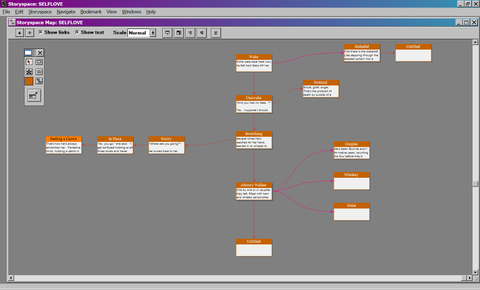
This seems very simple a framework, but I can visualize how it will expand and in what areas there will be alternative trails and how the story can return to itself in different spaces of time.
I really could use that cabin in the woods for this one though.
Posted in PROJECTS, STORYSPACE | Comments Off on STORYSPACE & PROJECTS: Self Love – Architecture






 The Lost Children: A Charity Anthology
The Lost Children: A Charity Anthology